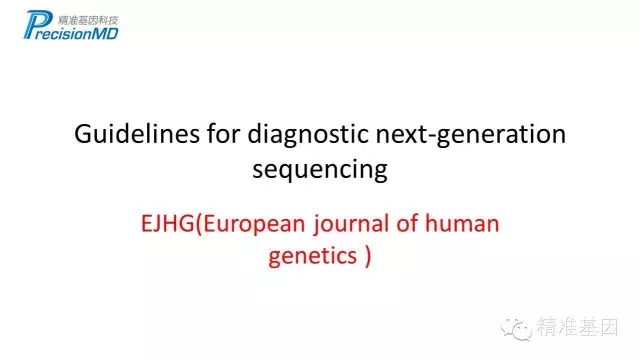登陆有奖并可浏览互动!
您需要 登录 才可以下载或查看,没有账号?立即注册


×
Nature子刊EJHG|NGS诊断指南发布
背景介绍:EJHG(European journal of human genetics)属于Nature子刊,近日发布了“Guidelines for diagnostic next-generation sequencing”,即NGS诊断指南。小编整理出来与大家共享,希望能得到一些启发,欢迎各位朋友批评指正。


•STATEMENT01: NGS should not be transferred to clinical practice
without an acceptable validation of the tests according to the
emerging guidelines. ••没有遵循指南验证的检测不能用于临床 •STATEMENT02: The laboratory has to make clear whether the test
that is being offered may be used to exclude a diagnosis, or to
confirm a diagnosis.
••检测机构必须阐明提供的检测是用于诊断还是筛查
•STATEMENT03: The aim and the utility of the test or assay should
be discussed at the beginning of the validation and a summary
should be included in the validation report. ••检测的目的与相关设备必须在检测前明确,并需要写进最终报告
•STATEMENT04: When a laboratory is considering introducing
NGS in diagnostics, it first has to consider the diagnostic yield. ••在进行NGS检测前,必须考虑已知诊断率
•STATEMENT05: For diagnostic purpose, only genes with a known
(ie,published and confirmed) relationship between the aberrant
genotype and the pathology should be included in the analysis. ]••如果目的是诊断,相关基因必须为明确与疾病相关
•STATEMENT06: For the sake of comparison, to avoid irresponsible testing, for the benefitof the patients, ‘core disease gene lists’
should be established by the clinical and laboratory experts
.••与疾病相关的最核心基因列表,必须由临床与检测机构的专家共同决定,目的是为了有可比性和完善性
•STATEMENT07: A simple rating system on the basis of coverage
and diagnostic yield, should allow comparison of the diagnostic
testing offer between laboratories. ••至少提供最基本的质控和检测结果,以便不同检测机构之间有可比性
•STATEMENT08: The laboratory has to provide for each NGS test
the following: the diseases it targets, the name of the genestested,
their reportable range, the analytical sensitivity and specificity,and,
if possible, the diseases not relevant to the clinical phenotypethat
could be caused by mutations in the tested genes
.••检测机构必须提供:检测疾病列表,相关基因,基因检测范围,敏感度与专一度(可选:其他与表型无关的致病突变)
•STATEMENT09: The analysis pipeline of diagnostic laboratories
should focus on the gene panel under investigation in order to avoid
the chance of secondary findings, and be validated accordingly.
••检测重点应该放在与疾病最相关的基因上,并做相关验证,尽量避免分析无关基因
•STATEMENT10: Laboratories should provide information on the
chance of unsolicitedfindings. ••不明确的突变要做详细说明(如隐性单杂合点)
•STATEMENT11: If a clinical center or a laboratory decides to offer
patients an opt-in, opt-out protocol to get carrier status for
unrelated diseases and secondary findings all the logistics need to
be covered. ••如果要报道与表型无关的突变,除了要符合相应法规,还要预先征得患者同意。
•STATEMENT12: The local policy about dissemination of unsolicited and secondary findingsshould be clear for the patient. ••患者需要明确当地关于报道检测之外突变的法规
••STATEMENT13:It is recommended to provide a written information leaflet or online availableinformation for patients. ••建议提供患者手写或在线版的知情书
•STATEMENT14: All NGS quality metrics used in diagnostics
procedures should be accurately described. ••所有质控参数必须精确提供
•STATEMENT15: The diagnostic laboratory has to implement a
structured database for relevant quality measures for (i)the
platform, (ii) all assays, and (iii) all samples processed. ••所有相关质控结果必须整理成数据库(平台,检测,样本)
•STATEMENT17: Accuracy and precision should be part of the
general platform validation, and the work does not have to be
repeated for individual methods or tests. ••保证平台的准确性与精确性,避免不必要的重复实验
•STATEMENT18: The bioinformatics pipeline must be tailored for
the technical platform used. ••生物信息学流程必须适合技术平台
•STATEMENT19: Analytical sensitivity and analytical specificity
must be established separately for each type of variant during
pipeline validation
.••不同种类的变异类型的检测准确性必须分别分析(snv,indel)
•STATEMENT20: The diagnostic laboratory has to validate all parts
of the bioinformaticpipeline (public domain tools or commercial
software packages) with standard data sets whenever relevant
changes (new releases) are implemented. ••当流程做改动时,必须用标准数据检验
•STATEMENT21: The diagnostic laboratory has to implement/use a
structured database for all relevant variants with current
annotations. ••必须建立本地变异数据库(用于检验变异真实性)
•STATEMENT22: The diagnostic laboratory has to take steps for
long-term storage of all relevant data sets. ••需要做长期存储数据的准备(bam,fastq)
•STATEMENT23: The reportable range, that is, the portion of the
clinical target for which reliable calls can be generated, has tobe
defined during the test development and should be available tothe
clinician (either in the report or communicated digitally). ••检测基因的范围必须提前确定并告知临床医师
•STATEMENT24: The requirements for ‘reportable range’ depend
on the aim of the assay. ••检测范围需要根据检测目的决定••
•STATEMENT25: Whenever major changes are made to the test,
quality parameters have to be checked, and samples have to be
re-run. The laboratory should define beforehand what kind of
samples and the number of cases that have to be assayed whenever
the method is updated or upgraded. ••当检测有较大改动时,所有质控参数必须检查,样本必须做对照实验,并且测试样本的性质与数量必须提前确定。•
•STATEMENT26: The report of a NGS assay should summarize the
patient’s identification and diagnosis, a brief description of the test,
a summary of results, and the major findings on one page. ••检测报告应该在一页之内包括如下内容:1. 患者身份及诊断信息,2. 检测的概括性描述,3. 结果总结,4. 结论
•STATEMENT27: A local policy, in line with international recommendations, for reportinggenomic variants should be established and
documented by the laboratory prior to providing analysis of this type.
••本地对基因检测报告的政策法规必须符合国际标准并在提供相关检测服务之前建立
•STATEMENT28: Data on UVs have to be collected, with the aim to
eventually classify these variants definitively.
••意义不明确的结果必须收集,为了之后确诊的可能
•STATEMENT29: Laboratories should have a clearly defined
protocol for addressing unsolicited and secondary findings prior
to launching the test.
••检测机构对未明确及次级发现的处理方案必须提前明确
•STATEMENT30: The laboratory is not expected to re-analyze old
data systematically and report novel findings, not even when the
core disease gene panel changes.
••检测机构不应该被要求反复分析检测报告,即使核心基因penal数量有改变,即只报道当前最明确的结果(但特殊情况除外)
•STATEMENT31: To be able to manage disease variants, the
laboratory has to set up a local variant database for thedifferent
diseases for which testing is offered on a clinical basis
.••为了便于管理,检测机构应该建立本地以临床诊断疾病为分类的变异数据库
•STATEMENT32: A diagnostic test is any test directed toward
answering a clinical question related to a medical condition of a
patient
.••诊断检测必须与患者疾病相关的临床问题直接相关
•STATEMENT33: A research test is hypothesis driven and the
outcome may have limited clinical relevance for a patient enrolled
in the project
.••研究实验以假设为前提,结果可不以临床为导向。
•STATEMENT34: The results of a diagnostic test, particularly by
analysis of a whole exome orgenome, can be hypothesis generating. ••临床诊断可以转为科学研究(尤其是WES或WGS),但临床诊断必须只分析疾病相关。
•STATEMENT35: Diagnostic tests that have as their primary aim to
search for a diagnosis in a single patient should be performed inan
accredited laboratory
.••对于单个患者,临床相关的检测必须在有资质的检测机构进行
•STATEMENT36: Research results have to be confirmed in an
accredited laboratory before being transferred to the patient.••研究性结果如果要告知患者,必须首先征得有资质的检测机构同意
•STATEMENT37: The frequency of all variants detected in healthy
individuals sequenced in a diagnostics and/or research setting
should be shared.••正常人群的变异数据应该共享。
•STATEMENT38: All reported variants should be shared by
submission to federated, regional, national, and/orinternational
databases. ••所有报告的变异应该提交到相关的组织机构,并由这些机构发布并共享
来源:精准基因
|  /3
/3 